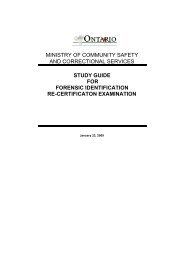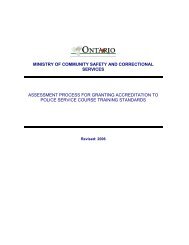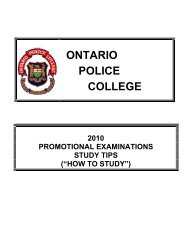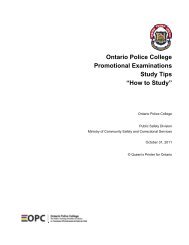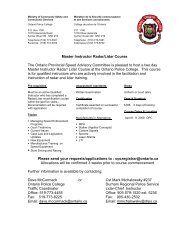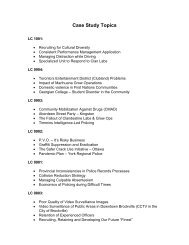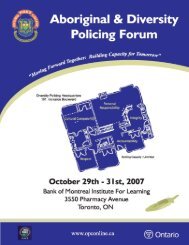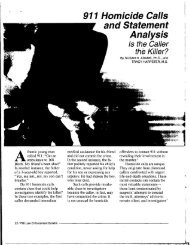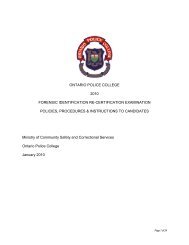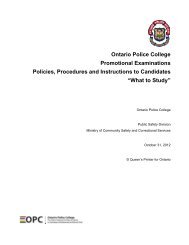General Study Guide - Ontario Police College
General Study Guide - Ontario Police College
General Study Guide - Ontario Police College
You also want an ePaper? Increase the reach of your titles
YUMPU automatically turns print PDFs into web optimized ePapers that Google loves.
Additional Latent Print Development Processes<br />
Latent Print Examination of Skin<br />
by Ed German<br />
updated 10 July 2001<br />
a<br />
Because the same chemicals naturally deposited in latent prints are also present on the rest of the body's skin, successful latent print detection on skin<br />
normally involves a contaminant of some type (blood, dirt, lipstick, wet paint, vaseline, etc.). I recommend detectives look carefully at the victim's skin<br />
for any obvious "finger or palm ridge detail" (not just red marks on the skin). Success may come in the form of just having your evidence technicians<br />
take pictures of visible prints.<br />
If the victim is wearing red or orange lipstick and the suspect put his hand on her (or his) mouth, you will have good potential for examining the live (or<br />
deceased) victim's body (and clothing, bed sheets, etc.) with an alternate light source or portable laser (viewing through AR goggles - typically orange) to<br />
see latent prints which are invisible in room light/daylight but glow brightly when excited with relatively monochromatic blue-green light. Red and<br />
orange lipstick contain dyes very similar to those we use in crime labs to "tag" faintly developed super glue fumed prints and make them glow brightly.<br />
Two schools of thought for developing latent (invisible) prints<br />
There are two schools of thought insofar as how to develop invisible (latent) friction ridge prints which may be on a body. They are the "lift transfer"<br />
method and "direct super glue fuming" method. It is possible to use both methods (lift transfer, then fuming) on cadavers, though most experts tend to<br />
use only one or the other. (Note – Per OPC Training Manual – “Magnetic powders have been used with limited success on cadavers in homicide cases.”<br />
Lift transfer method<br />
Known for decades as the "iodine fuming silver transfer lift" method, the development of fatty/waxy contaminant latent prints transferred from skin<br />
onto a nonporous surface is still quite popular... but now with improved transfer mediums and post-transfer development. Since the 1990's, super glue<br />
development of the transferred prints has generally replaced old fashioned exposure of silver plates to actinic lighting for developing impressions.<br />
Latent Print Examiner William Sampson from Florida has contributed to much of the modified transfer lift research for skin.<br />
For live victims, a piece of black plastic (such as RC photo paper developed as black) can be held against areas suspected as possibly bearing latent<br />
(invisible) prints. Other nonporous surfaces such as a mirror, glass, or metal plate may be used instead of photo paper. Some examiners use a sponge or<br />
soft pad between their hand and the photo paper to improve contact the victim's skin.<br />
Hold the transfer surface against the skin for 15 to 20 seconds. The nonporous transfer surface should then be super glue fumed to develop latent prints<br />
which may have transferred. There is no need to wait for "water content drying" because any water in the latent print residue will aid polymerization<br />
with super glue fumes.<br />
After super glue fuming, further development of the nonporous transfer surface should include luminescent dye stain, laser or alternate light source<br />
excitation, and (lastly) powder rubbing.



